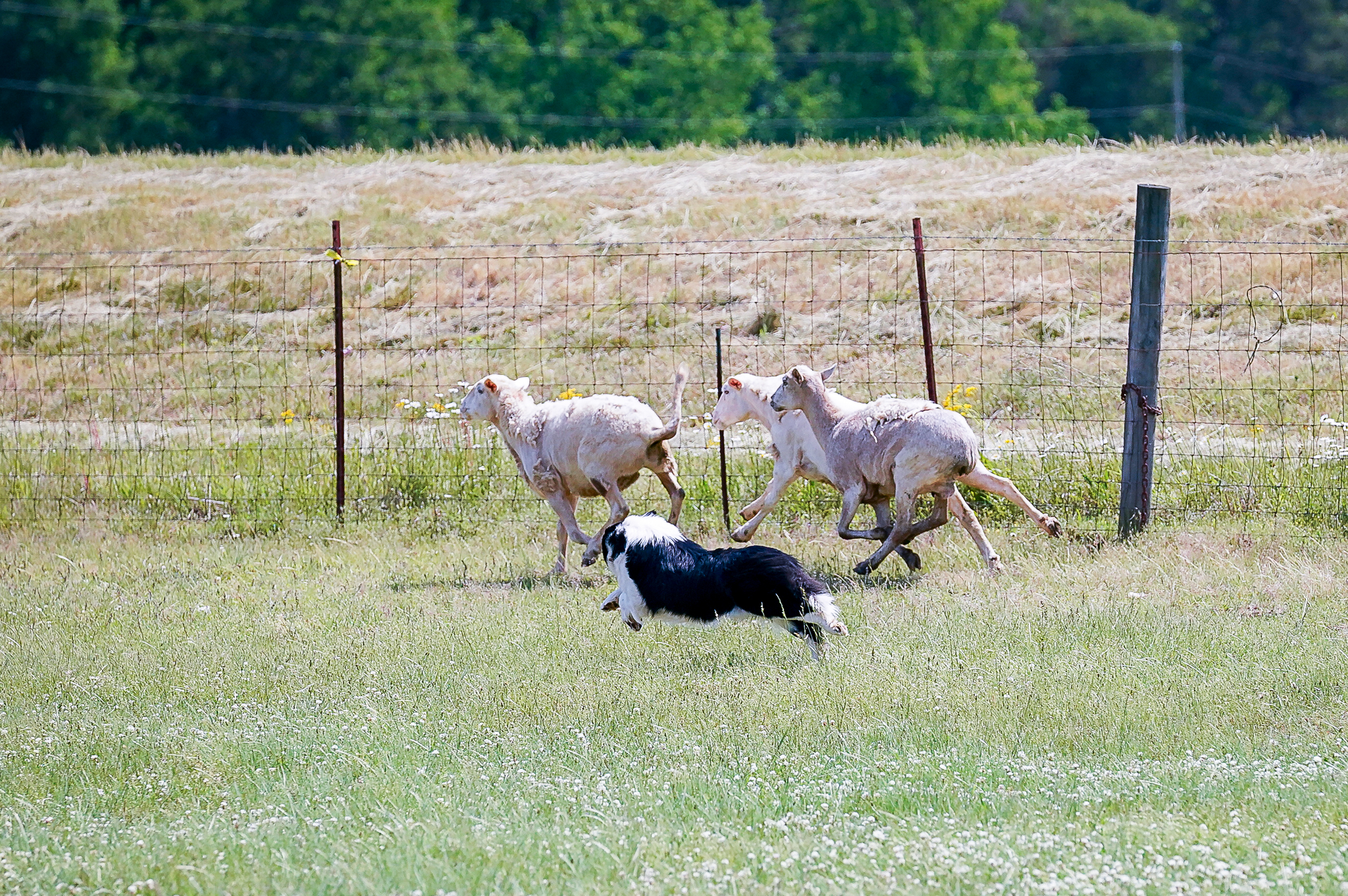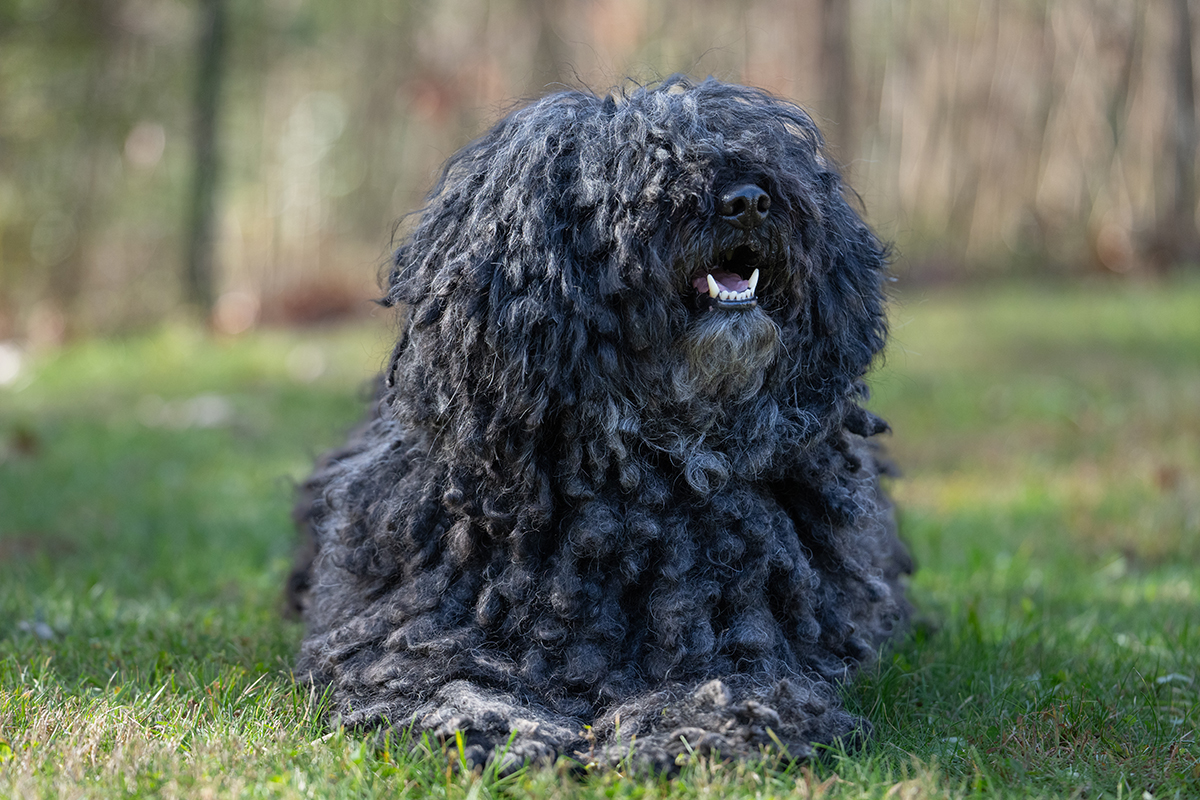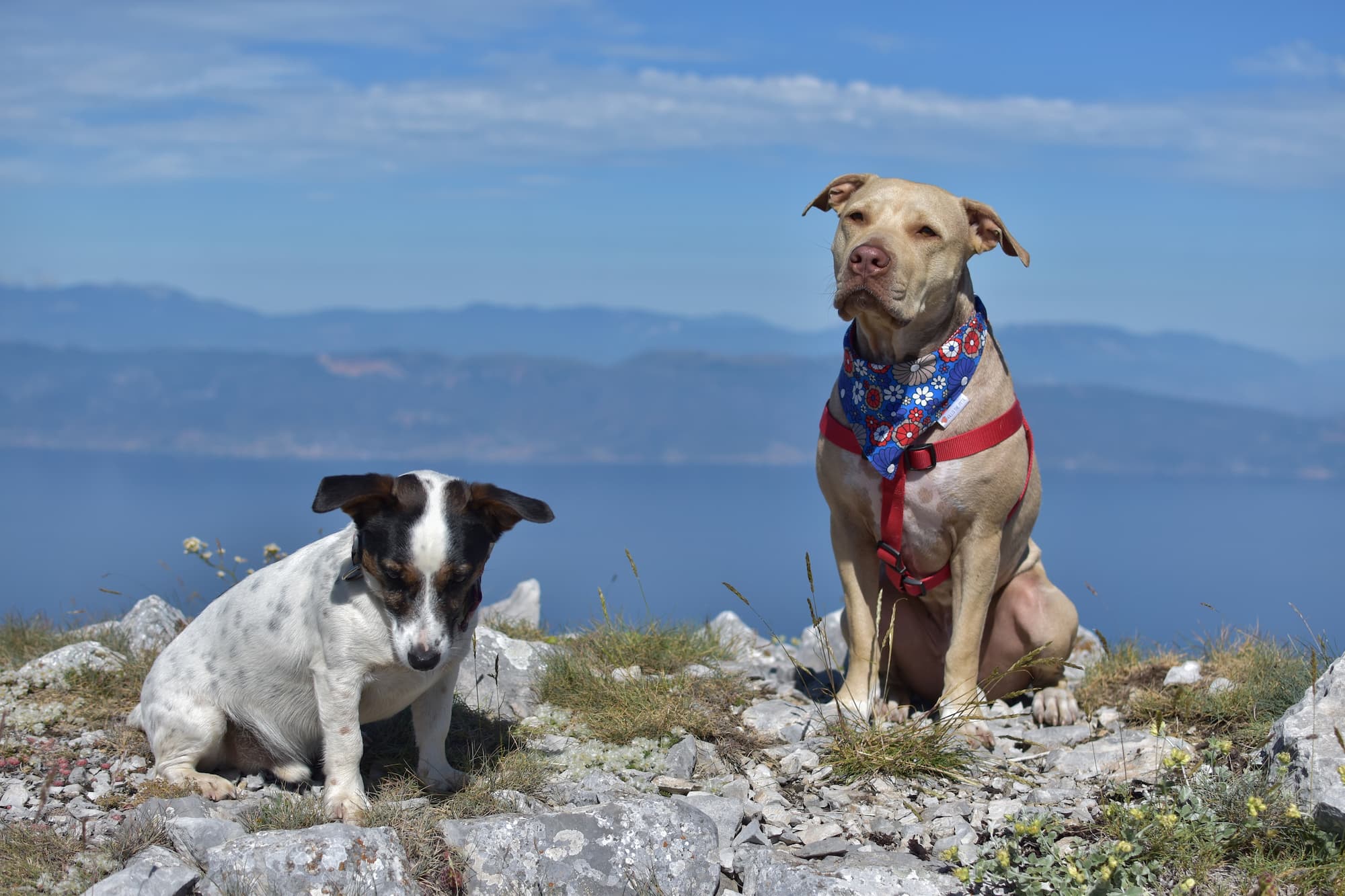Dog herding has its own special language, which is difficult to decipher, especially for those new to the sport. Even those who have been training for a little while may find confusion in herding terms, especially when training with a new trainer, who seems to interprets certain herding commands differently. Here is a complete list of herding commands, AKC terms (used in scoring runs) as well as commonly used expressions, decoded for the newbie and the layman.
A-B Herding Command and Terms
ATTEMPT: Typically used in trial scoring. The attempt initiates when “the livestock crosses the plane of the obstacle.” This means the livestock has passed the entrance point, either by going into the obstacle or missing it, and blowing past the entrance of the obstacle. You must attempt every obstacle on a course.
BACK/LOOK BACK: Command given for the dog to look back, as one or more of the stock is lagging behind. Also, command for the dog to get back behind the stock, if it is attempting to head them.
BALANCE/THE BALANCE POINT: The point of balance is opposite to the handler, with the stock in between the dog and handler. A dog that balances naturally, reacts to the handler’s motion by moving correspondingly in the opposite direction of the handler. The dog maintains his position opposite the handler, and holds the sheep to the handler.
Controlling The Dogs Movement with Your Body Position
In fetching, ideally the dog naturally balances, by moving opposite of the handler, to hold the stock to the handler. For example, if I take a step to the right, and the sheep are walking behind me and the dog is pushing them forward, the dog then takes an equivalent step or steps to the left. In this way, you can control the dog silently by moving in the opposite direction of where you want the dog to be.
It should be noted that the balance point, in practical terms, varies depending on where the draw is. If the handler is at 12:00, and the draw is at 3:00, the dog might find he is best positioned at 4:30-5:00, rather than 6:00, to keep them from escaping to the draw at 3:00.

BIDDABILITY: The willingness of the dog to do his master’s bidding. The desire to please.
BLIND OUTRUN: When the handler and dog cannot see the stock from the handler’s post.
BUBBLE: In the arena, three bubbles exist. The bubble is the space around the stock, dog or handler, that is their comfort zone. If we look at the diagram above, we see a circle that is the bubble around the livestock. The dog may move outside of that circle without exciting the livestock into motion (flanks). Different livestock will respond differently to a dog intruding into their bubble.
- Sheep: Sheep will bunch together, shoulder to shoulder when the dog gets too close to them.
- Ducks: Ducks will scatter when the dog gets to close to them.
C-E Herding Commands and Terms
CHASING: The dog runs after the stock, with no intention of controlling the stock. This is out of control behavior, and can result in damage to the livestock by running them into fencing. Chasing will cause the run to be called-off by the judge.
COME-BYE/GO-BYE: A command to move the dog clockwise around the livestock.
CONTACT: A dog can be “on contact” or “off contact.”
- On Contact means the dog is interested and actively engaged in moving the stock through the course.
- Off Contact means the dog is not engaged in working the stock. The dog may just be following the handler through the course, while the dog is distracted by other interests. An off contact dog may also lose control of the stock by being too far away from them.
- Dogs must be on contact to properly qualify their run.
COURSE: A designated pattern of obstacles through which a handler directs the dog. In AKC Herding there are the A Course in the arena, B Course in a large field, and C Course. C course is for tending breeds, moving sheep, between 20-100 of them, from one grazing area to another, along a narrow road up to 880 yards long.
COVER: The dog understands, without direction, where the stock would like to escape to, and holds them away from the “draw.” The dog “covers” by detecting their desire to flee, and then placing himself in a position to prevent the flight.
CROSS DRIVE: This is the drive across the arena through the center-line gait. The centerline gate is comprised of two panels in the center of the arena, with an opening between them, that the stock proceeds between.
CROSS-OVER: This occurs when the dog crosses over the path the stock is intended to take. Crossover can occur on the Outrun, when the dog crosses over from the side his is sent and intended to approach from, between the sheep and handler. It also occurs when circling the stock, to no purpose. Cross-over inhibits the stocks ability to move forward, in the intended direction.
DOWN/LIE DOWN: The command to stop the dog in a down position. Down removes the pressure from the stock and allows the dog and stock to settle. Stop can be used as well, to pause the forward motion.
DRAW: The draw is the place where the stock wants to go for safety or food. Typically it is the pen area they came out of (which has the rest of the livestock) or the exhaust gate. A feed pan with grain in it can be the initial draw, to hold the stock still at the start of the run. The dog must work harder to push the stock away from the draw or “cover” the stock from escaping to the draw.
DRIVING: Moving the stock away from the handler. When starting on driving, the dog is usually positioned between the stock and the handler. In higher levels of AKC herding, the dog drives the sheep around the arena, while the handler remains stationary.
EXHAUST/EXHAUST PEN: This is where the stock is let out of the arena at the end of the run.
EYE: There are two types of herding styles: dogs who use “eye” and “loose-eyed” dogs. Dogs with eye use their stare to control stock. Border collies fall into this category. They tend to work with their heads down, and to stalk in a crouched manner. This is also referred to as “style.” Loose-eyed dogs are more upright in their posture when approaching stock.

F-G Herding Commands and Terms
FETCH: Part of the initial sequence of a trial run, it follows the outrun and the lift. The fetch is bringing the stock to the handler.
FETCHING: Moving the stock toward the handler. When fetching, the dog is usually positioned so that
the stock are between it and the handler. Ideally, we want the dog to bring the stock to the handler and follow the handler at a controlled pace.
FLANKING: Circling the sheep from the right or left to keep them in a group or change their direction. The dog remains outside of the bubble when flanking, to reposition himself, before moving the stock in a new direction. Flanks are typically followed by a “there” and “walkup” command.
- INSIDE FLANK: The dog passes “inside” meaning between the stock and the handler. To encourage an inside flank, handlers may choose a flanking command similar to the standard flank command such as “Wee” for Away or “Bye” for come bye.
- SQUARE FLANK: Squaring up the dog in relation to the stock. The dog is flat-sided to the sheep at a 90 degree angle as he flanks. He should be off contact while flanking, and will go back on contact, when the handler says “There.”
FLIGHT ZONE: An invisible area around the stock, within the bubble. The dog cannot pass into the flight zone without causing the stock to feel threatened and attempting to escape from the dog.
FLOCKING: The tendency of the stock to instinctively cluster together in a compact group that then functions as a unit. Generally, speaking cattle do not have a strong flocking tendency. As noted earlier, fowl tend to scatter when the dog steps into the flight zone, while sheep bunch together.
GATHER: The act of collecting the stock from their scattered grazing positions, into a compact group.
GRAZE: Allows the stock time to settle and feed in a designated area. Allowing the stock a moment to settle before beginning the run, builds trust with the stock in the handler.
GRIPPING: Biting the hocks of the stock. A grip will elicit a warning from the judge. Repeated gripping will warrant an “Excusal” from the judge.
H-N Herding Commands and Terms
HANDLER’S MEETING: In AKC herding, prior to each level of the test or trial, the Judge will have a handler’s meeting. Here the judge explains their expectations, as well as what will cause them to call a run off. Handler’s are permitted to ask the judge questions regarding their priorities in scoring.
HANDLER’S POST: The designated point at which the handler and dog begin the run.
HEADING: Heading the stock refers to the dog going ahead of the livestock to stop or slow their progress. This can be useful when the stock are headed toward the draw, and counter productive if he continually halts forward progress.
HEAVY STOCK: Stock that requires a great deal of pressure from the dog in order to be moved. Heavy stock is likely to group around the handler, and then is referred to as “knee knockers” as it can make it difficult for the handler to walk in the tight grouping of the stock.
HERDING INSTINCT: The inherited balance in a dog’s temperament, between the predatory drive and
the dog’s willingness to submit to its handler. The stronger the herding instinct, the stronger must be the desire to comply with the commands of the handler.
HOLDING PEN: The pen on the outside of the arena or field, where the livestock is held before trial runs.
LACK OF FORWARD PROGRESS: The stock has stopped on the course and the dog is having a hard time pushing them forward. This can occur in corners, pens or inside of chutes. Points will be deducted for prolonged lack of progress, or the run may be called.
LIFT: The second part of the initial sequence of a trial run. The lift is the moment following the outrun, when the dog reaches livestock and begins to move them from their starting point. Ideally the dog begins the lift at the opposite side of the stock from the handler (the balance point) and moves them directly toward the handler, the Fetch.
LIGHT STOCK: Stock that are moved with light pressure from the dog and may not be interested in joining the handler either. Light stock tend to bolt when the dog enters their bubble into the flight zone.
O-P Herding Commands and Terms
OBSTACLES: Objects placed in strategic locations to make up a trial course. Obstacles can be pens, chutes, fences, or points on the course that must be arrived at before proceeding to the next obstacle.
OFF LINE: There is a 10 foot wide path the stock should progress through in passing all of the obstacles. When the stock strays out side of this 10 foot wide path, they are offline, and points will be deducted.
OUT: This is a command for the dog to disengage from the stock (go off contact) and move away from the stock, until told to stop or change direction.
OUTRUN/CAST: The handler sends the dog from the handler’s post. The dog then runs in a pear-shaped or semi-circular arc to move from the handler’s post to the balance point, on the far side of the stock, in order to move/Lift the stock to the handler (the Fetch).
PARALLEL DRIVE: The position of the handler in relation to the dog while driving. The Handler walks parallel to the dog, as it pushes the stock forward.
PEN/RE-PEN: To put the stock into a specified holding area or Exhaust Pen.

Judge’s Removal of Competitors
RETIRED: At the request of the handler, the run is ended. Typically this is signaled by the handler calling the dog to them, and saying “Thank you,” to the judge.
REMOVED FROM THE RING: A Judge’s decision to end the run because the dog is lame, sick, or
unproductive.EXCUSED: A Judge’s decision to end the run because the dog is chasing, attacking or attempting to attack the stock or the dog is gripping abusively. A separate report is made to AKC when a dog is excused. When a dog has been excused three times, the owner is advised by AKC that the dog is no longer eligible to be entered in AKC Herding events until the dog has been successfully completed a re-evaluated.
DISQUALIFIED: A Judge’s decision to end the run because the dog has attacked or attempted to
attack a person. A dog which is disqualified is no longer eligible to enter any AKC event, and the dog is
not eligible to be entered unless and until, following application by the owner to The American Kennel
Club, the owner has received official notification that the dog’s eligibility has been reinstated.TIME: If the dog has run out of time, the timer will call “Time,” and the handler must collect their dog, say, “Thank you,” to the judge and exit the arena through the exhaust gate.
PRESSURE/POWER: The influence of the dog’s presence on the stock, and the authority of the dog’s
character. The extent of this latent force within a dog will determine the behavior of stock and their
flight zone for that particular dog.
Pressure can also be exerted by the handler on the dog. A dog who feels the handler’s pressure negatively may quit working and eat sheep dung or go the the gate and lie down.
PRESSURE POINT: The exact position and distance the dog needs to be at in order to move livestock in
the desired direction. This position is directly influenced by the livestock’s natural inclination to be
drawn to the pen from which they were released, a gate to pasture, a known food source, other
livestock or a water source if they are thirsty.
PUSH: The act of moving the stock forward either by use of “eye” or physical presence.

R-W Herding Commands and Terms
RATE/RATING STOCK: Moving the stock at a consistent speed. The dog is both covering the stock as well as pushing the stock to maintain a consistent rate of speed. The dog is not running behind them, at whatever speed the stock chooses. He neither pushes to hard, nor does he fall too far behind the stock.
READ: The ability of the handler to understand and anticipate the thoughts of the stock and/or the dog
in order to maintain control over both. The ability of the dog to anticipate the behavior of the stock.
RETREAT: The stock have turned around and are moving in the opposite direct than intended. A retreat will cause points to be deducted.
RUN: Each individual dog’s trial performance, per course.
SETTLE: Allows the stock time to calm and adjust to the situation. Typically the dog is commanded to “Stop” or “Lie Down” to allow the stock to settle.
SHED: The dog separates the livestock and holds a group or individual for a specific length of time within a specified area. In practical terms, the shed is used to separate certain animals from the flock or herd for medical treatment or some other intervention.
STEADY: Command to slow the dog down.
STOP: Used to pause the motion, without the dog fully going into a down. Often used when the handler is concerned that the motion of the dog rising from a down will spook light sheep.
TENDING: The supervision of the flock, by the dog, as the flock is grazing. A style of herding used when
pastures are unfenced and the dog serves as a living fence.
THAT WILL DO/THAT’LL DO: The dreaded command releasing the dog from his work, and calling the dog to the handler.
THERE: The command used when flanking, to stop the dog and have him turn into the stock. The dog naturally goes back “on contact” with the stock when he turns in. “There” is often first taught with the commands “There” “Down” and “Walkup” spoken in quick succession. Ultimately, the “There” command should result in the dog turning into the sheep, stopping and awaiting the next command.
.WALK ON/ WALK UP: A command for the dog to walk toward the sheep.
WEAR/WEARING: A method of moving stock by pushing them forward while moving from side to side in an arc, behind the stock. This helps to keep the stock grouped together.
Final Thoughts
Herding is fun, and probably the hardest of the AKC sports you can train and compete in. After all there are usually at least 5 brains in the arena with different ideas about what should happen on the run.
In training you can use any words that suit you to train your dog in herding. In fact I know a herding judge who uses Gee and Haw instead of come bye and away to me, just to have some fun with that dogs training. Just remember, being consistent in your commands is the key to being successful in all dog training. However, if you want to understand your trainer, having a firm understanding of herding terms before your lessons, will help you progress more quickly. Additionally, once you start trialing, you will want to understand the judges notes regarding the deductions you received on your run.
Feel free to ask questions or for further clarification in the comments section. Happy herding!




